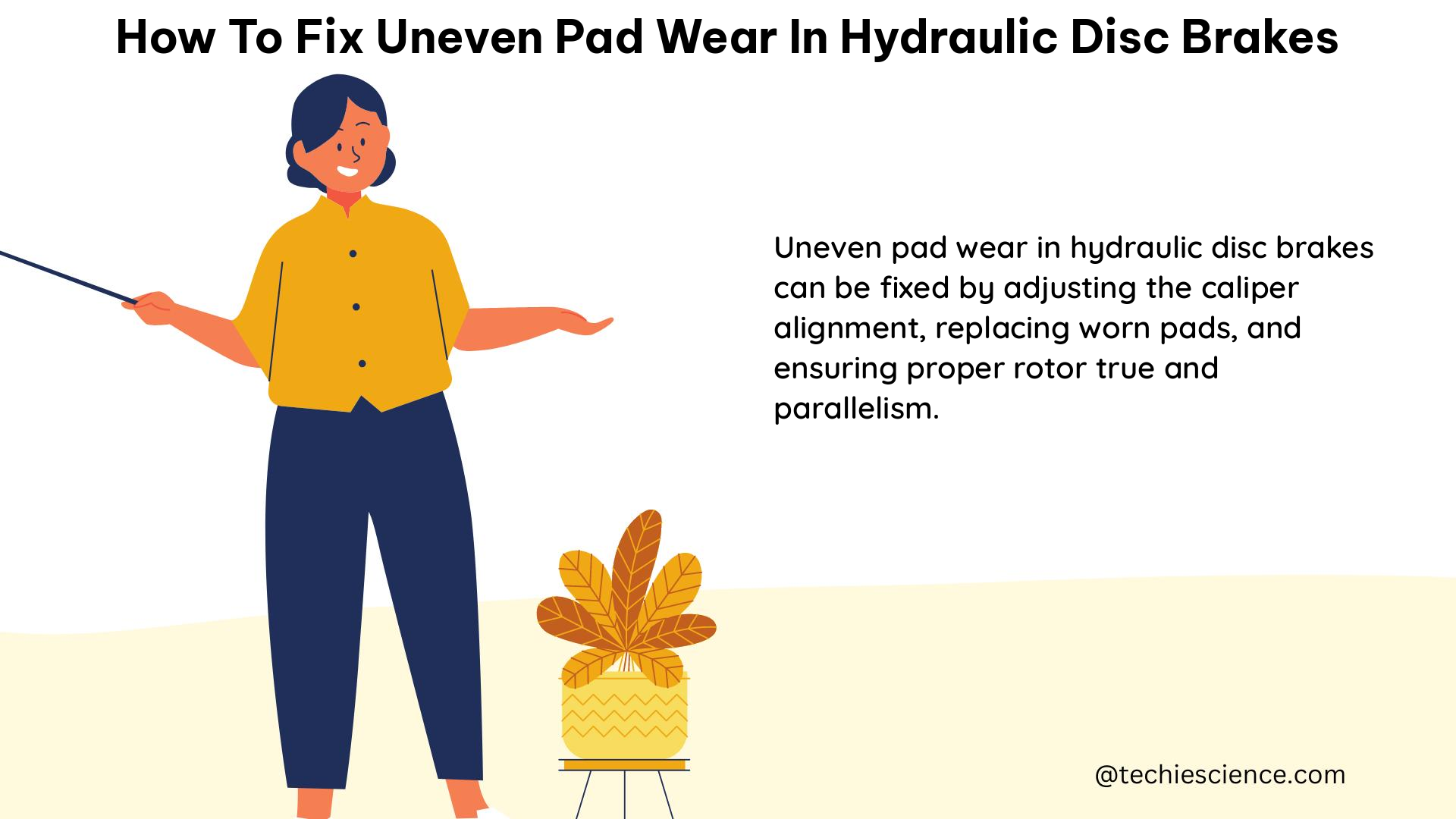Uneven pad wear in hydraulic disc brakes is a common issue that can significantly impact the performance and lifespan of your braking system. This comprehensive guide will provide you with a deep understanding of the underlying physics, step-by-step instructions, and technical details to effectively address this problem and ensure your brakes function optimally.
Understanding the Physics Behind Uneven Pad Wear
The primary cause of uneven pad wear in hydraulic disc brakes is the uneven distribution of the friction force between the brake pads and the rotor. This friction force is governed by the principle of friction, which states that the force required to overcome the resistance between two surfaces in contact is proportional to the normal force (the force perpendicular to the surfaces) and the coefficient of friction between the surfaces.
When the brake pads are not properly aligned with the rotor, the friction force is not evenly distributed across the pad surface. This can lead to some areas of the pad experiencing higher wear rates compared to others, resulting in uneven pad wear.
The mathematical relationship between the friction force (F), the normal force (N), and the coefficient of friction (μ) can be expressed as:
F = μ × N
To ensure even pad wear, it is crucial to adjust the toe-in of the brake pads, which is the amount of inward or outward tilt of the pads relative to the rotor. By adjusting the toe-in, you can achieve a more even distribution of the friction force, prolonging the life of the pads and improving the overall braking performance.
Measuring Uneven Pad Wear

To accurately assess the extent of uneven pad wear, you can use a micrometer or a vernier caliper to measure the thickness of the pad material at different points. Specifically, you should measure the thickness at the leading edge, the trailing edge, and the middle of the pad.
The difference in thickness between these points can provide valuable insights into the degree of uneven wear. For example, if the leading edge of the pad is significantly thinner than the trailing edge, it indicates that the friction force is not evenly distributed, and adjustments are necessary.
Adjusting the Toe-in of Brake Pads
To fix uneven pad wear, you need to adjust the toe-in of the brake pads. The recommended toe-in range is typically between 0.5 to 1 mm. Here’s a step-by-step guide on how to adjust the toe-in:
- Loosen the bolt that holds the pad holder in place.
- Squeeze the brake lever to align the pad with the rotor.
- Insert a thin piece of cardboard or a shim between the pad and the rotor at the trailing edge of the pad.
- Tighten the pad holder bolt while maintaining the desired toe-in.
- Repeat the process for the other pad.
Alternatively, you can carefully bend the caliper or the brake arm to adjust the position of the pads and achieve the desired toe-in.
Preventing Uneven Pad Wear
To prevent uneven pad wear in the long term, you should also pay attention to the condition of the rotor and the brake fluid. A variation in disc thickness can cause the pads to wear unevenly, and this can usually be corrected by machining the rotors or replacing them.
Improper operation of the calipers, such as seized guide pins, can also lead to uneven pad wear. To prevent this, you should regularly check and lubricate the guide pins during brake pad replacement.
Additionally, ensuring the proper operation of the brake system, including the condition of the brake fluid, can help maintain even pad wear. Contaminated or degraded brake fluid can affect the performance of the hydraulic system, leading to uneven pad wear.
Troubleshooting Uneven Pad Wear
If you continue to experience uneven pad wear even after adjusting the toe-in, there are a few other factors you should consider:
- Rotor Condition: Inspect the rotor for any warping, grooves, or uneven wear. If the rotor is in poor condition, it may need to be machined or replaced.
- Caliper Alignment: Ensure that the caliper is properly aligned with the rotor. Misalignment can cause uneven pad wear.
- Seized Guide Pins: Check the caliper guide pins for any signs of seizure or binding. Lubricate or replace the guide pins as necessary.
- Brake Fluid Condition: Inspect the brake fluid for any contamination or degradation. If the fluid is old or contaminated, it should be flushed and replaced.
By addressing these potential issues, you can further optimize the performance of your hydraulic disc brakes and maintain even pad wear over time.
Conclusion
Fixing uneven pad wear in hydraulic disc brakes requires a deep understanding of the underlying physics and a systematic approach to adjusting the toe-in, measuring the wear, and maintaining the overall brake system. By following the steps outlined in this comprehensive guide, you can ensure your brakes perform optimally and last longer, providing you with a safer and more reliable riding experience.
References
- How can I adjust for uneven brake wear? – Bicycles Stack Exchange
- How to Fix Uneven Brake Wear – YouTube
- How to Identify & Fix Uneven Brake Pad Wear | Jiffy Lube
- uneven disc brake pad wear – Mountain Bike Reviews Forum
- How to Align a Hydraulic Disc Brake on a Bike – YouTube

The lambdageeks.com Core SME Team is a group of experienced subject matter experts from diverse scientific and technical fields including Physics, Chemistry, Technology,Electronics & Electrical Engineering, Automotive, Mechanical Engineering. Our team collaborates to create high-quality, well-researched articles on a wide range of science and technology topics for the lambdageeks.com website.
All Our Senior SME are having more than 7 Years of experience in the respective fields . They are either Working Industry Professionals or assocaited With different Universities. Refer Our Authors Page to get to know About our Core SMEs.